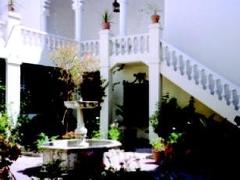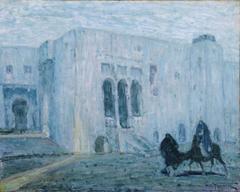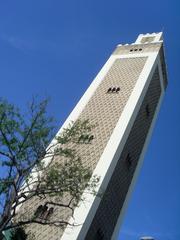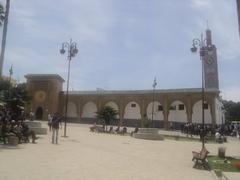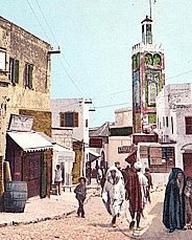National Cricket Stadium Tangier: Visiting Hours, Tickets, and Travel Guide
Date: 04/07/2025
Introduction: History and Significance
The National Cricket Stadium in Tangier, Morocco, is a landmark in African sports history and a testament to Morocco’s aspirations to diversify its athletic culture. Established in 2002, it was Morocco’s first purpose-built international cricket venue constructed to International Cricket Council (ICC) standards. The stadium brought global attention to North Africa by hosting the 2002 Morocco Cup, a tri-series featuring Pakistan, South Africa, and Sri Lanka—the first ICC-recognized ODI event in the region. Though its activity has declined in recent years, the stadium remains a symbol of Morocco’s sporting ambitions and its role in fostering international sporting relations. For more on its background and significance, see Wikipedia and Emerging Cricket.
Contents
- Introduction and Historical Background
- Vision and Construction
- Landmark Events: The 2002 Morocco Cup
- Development and Decline
- Visiting Hours and Entry
- Accessibility and Travel Tips
- Facilities and Stadium Layout
- Visitor Experience and Practical Tips
- Nearby Attractions
- Weather and Best Time to Visit
- Safety and Cultural Considerations
- Economic and Cultural Impact
- FAQs
- Conclusion and Visitor Recommendations
- Sources
1. Vision and Construction
The stadium was conceived by Emirati businessman Abdul Rahman Bukhatir, who sought to introduce cricket to the Arab world. Completed in 2002, it was the first of its kind in North Africa, built to ICC specifications for ODI matches, and established Tangier as a unique regional sporting hub (Wikipedia; Emerging Cricket).
2. Landmark Events: The 2002 Morocco Cup
The 2002 Morocco Cup was the stadium’s international debut, featuring seven ODIs with cricketing giants Pakistan, South Africa, and Sri Lanka. The event introduced North African audiences to high-level cricket and turned Tangier into a focal point of the cricketing world, albeit briefly (Cricbuzz).
3. Development and Decline
Post-tournament, the stadium supported local cricket development, hosting events such as the 2004 Marylebone Cricket Club (MCC) tour and youth clinics. However, administrative disputes led to the Royal Moroccan Cricket Federation’s suspension and expulsion from the ICC in 2019. Since 2013, the venue has seen little activity and has fallen into disrepair (Bladi.net).
4. Visiting Hours and Entry
Due to its current state, the National Cricket Stadium is not open for regular matches or official tours. However, the exterior and surrounding grounds can typically be viewed from 9:00 AM to 6:00 PM. For updates on possible events or special openings, consult local tourism offices or the Moroccan Cricket Federation.
- Tickets: No tickets are required for casual exterior visits. For special events (if any), ticket information is available through local cricket associations or official event organizers.
5. Accessibility and Travel Tips
- Location: Located in the Ziaten district, approximately 10–15 km from Tangier city center and Ibn Battuta International Airport.
- Transport: Best reached by taxi or private vehicle; limited public transport options are available. Parking is basic but adequate.
- Travel Tip: Wear comfortable shoes and exercise caution, as maintenance is limited (worldweatheronline.com).
6. Facilities and Stadium Layout
- Seating Capacity: Approximately 5,000
- Bowling Ends: Pavilion End and Cape Spartel End
- Spectator Facilities: Basic, with open seating and minimal hospitality areas
- Player Amenities: Changing rooms, practice nets
- Accessibility: Limited for people with disabilities; some ramps, but not all areas accessible (cricket.com)
7. Visitor Experience and Practical Tips
- Ambiance: Expect a quiet, informal atmosphere; ideal for cricket history enthusiasts or photographers.
- Food and Drink: On-site options are minimal; bring water and snacks.
- Photography: Permitted, but ask permission before photographing people.
- Dress Code: Modest, comfortable clothing is advised.
8. Nearby Attractions
Enhance your visit by exploring Tangier’s cultural and historical sites:
- Kasbah Museum
- The Medina
- Caves of Hercules
- Cape Spartel
- Grand Socco Square
For more, see AwayWithTheSteiners and PassaporteNoBolso.
9. Weather and Best Time to Visit
- Ideal Months: May, June, and September, with pleasant temperatures (22–28°C).
- Summer: Warmer but manageable; bring sun protection.
- Rainy Season: March and November—check forecasts before visiting (worldweatheronline.com).
10. Safety and Cultural Considerations
- Standard Precautions: Avoid isolated areas at night, and secure valuables.
- Local Customs: Dress modestly, avoid public displays of affection, and be respectful with photography.
- Alcohol: Not served at sporting events (travelmoroccotoday.com).
11. Economic and Cultural Impact
The stadium, though underutilized, stands as a symbol of Morocco’s sporting ambition. Major cricket events can boost local tourism, support jobs, and foster community engagement. Tangier’s strategic position between Europe and Africa makes it a potential hub for future ICC events, provided administrative and infrastructural challenges are addressed (StadiumDB; Sixes Cricket Blog).
12. Frequently Asked Questions (FAQ)
Q: Can I watch a cricket match at the stadium?
A: Currently, no matches are held due to the stadium’s inactivity.
Q: Are tickets required for visiting?
A: Not for exterior visits. Event tickets (if any) must be purchased in advance.
Q: Is the stadium accessible by public transport?
A: Public transport is limited; taxis or private cars are recommended.
Q: Are guided tours available?
A: Not regularly; check with local cricket groups for special events.
Q: What attractions are nearby?
A: The Medina, Kasbah Museum, Cape Spartel, and Caves of Hercules.
13. Conclusion and Visitor Recommendations
The National Cricket Stadium Tangier encapsulates both the promise and the challenges of developing new sporting traditions in North Africa. Though currently inactive, it invites reflection on Morocco’s sporting identity and provides a unique destination for those interested in cricket history or Tangier’s broader cultural landscape. Combine your stadium visit with trips to nearby historical sites for a richer experience, and consult local resources for the latest updates on access or special events.
For more travel tips and updates, download the Audiala app and follow official cricket and tourism channels.
Sources
- National Cricket Stadium Tangier Wikipedia, 2025
- Emerging Cricket: Morocco Team and Stadium Profile, 2025
- Cricbuzz: National Cricket Stadium Venue Details, 2025
- Bladi.net: Abandoned Cricket Stadium Tangier Article, 2025
- Cricket.com: National Cricket Stadium Tangier Facilities and Visiting Info, 2025
- WorldWeatherOnline: Tangier Weather and Stadium Visit Tips, 2025
- PassaporteNoBolso: Tangier Travel and Stadium Visit Guide, 2025
- Travel Morocco Today: Best Time to Visit Tangier, 2025
- AwayWithTheSteiners: Things to Do in Tangier, 2025
- StadiumDB: Grand Stade de Tanger and Sports Infrastructure, 2025
- GoWithGuide: Tourism in Tangier 2024 Statistics and Travel Guide, 2025
- Sixes Cricket Blog: Impact of Cricket on Tourism and Local Economies, 2025
- Sixes Cricket Blog: Cricket in Promoting Cultural Exchange, 2025
